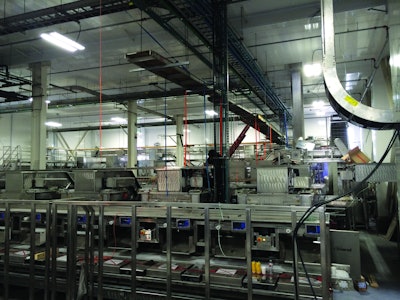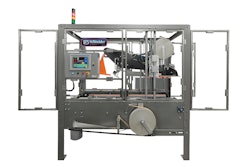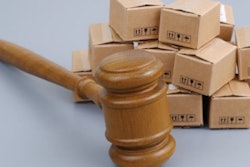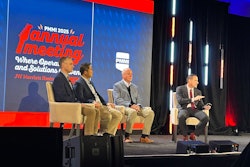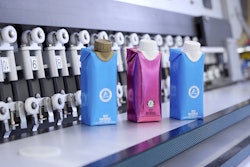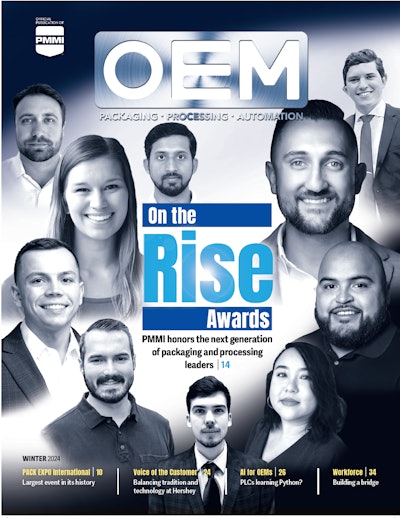Two hundred and fifty miles southwest of Anchorage, Alaska lies Kodiak Island, home to the Kodiak bear, king crabs, and a burgeoning commercial fishing industry. While the island’s location makes it ideal for catching and processing fish, the stark remoteness of Kodiak, coupled with harsh winters and constantly wet environment, does not make it especially enticing for year-round workers.
A majority of the workforce in fisheries and other processing plants on and near Kodiak come from outside of Alaska. That means feeding, housing, and transporting workers to and from the island begins to eat away at companies’ bottom line. Reducing labor through automation in these conditions transforms from an operational ideal to a vital necessity.
Enter Marel, a processing OEM specializing in manufacturing machinery for protein producers. Founded in Iceland in 1980 and still based there (so it can sympathize with unique Kodiak Island fish producer-requirements), the company has primary manufacturing plants in the U.S.—Seattle and Gainesville, Ga.—as well as Denmark, Holland, and locations in 30 other countries.
R&D driven
As an innovation-driven company, Marel invests between 5 to 7 percent of its revenue back into R&D, focusing on product development, improving product yield, process efficiency, throughput, and product quality.
“We do a lot of research, working with our customers to develop new protein products for the market—both in retail and food service—and developing equipment and solutions around that,” says Arnar Olgeirsson, innovation manager at Marel. “Our primary focus is on modular solutions and standard equipment for the market.”
The company now produces machinery for processing red meat, pork, and even select dairy products in addition to fish. But fish producers’ special needs land squarely within Marel’s original core competencies—processing equipment built to stand up to special hygienic conditions and a constantly wet environment.
When a Kodiak Island-based seafood production plant (name withheld) was faced with the need for an automated solution to address labor and manpower issues, it approached Marel for help. The OEM, who has been supplying equipment to the Alaska fishing industry since the mid-1980’s, took this opportunity as a challenge to create one of the most advanced fish processing plants in the world.
The name of the game in workforce-thin areas is automation, so the real metric for success for Marel’s fish-producing end-user customer became increasing the pounds of fish per man/hour, while maintaining good function in such specialty conditions.
Tackling the unknowns
While Marel was no stranger to fish processing in Alaska, implementing a full-plant solution on Kodiak Island was a first.
“The level of automation that we were attempting with Kodiak Island, and with the nature of fish processing, meant that there were a lot of unknowns and challenges. Building the equipment to withstand the wet environment that [a fish processing plant] operates in is a challenge. The [seafood products] are all different in size and weight and you have to build equipment to be able to handle different size ranges,” says Olgeirsson.
As its client dealt with four varieties of fish—salmon, cod, pollock, and flat fish—Marel’s solution needed proven modular components that would create a custom application. Marel used its abilities as an OEM integrator by building 50 percent of the solution in house, with the remaining half, such as freezers, freezer controls, and robotics, being contracted out.
“In this instance, we are handling all phases of processing, from receiving to final goods delivery. Modularity is most necessary on the receiving end, with different fish species to contend with,” Olgeirsson says.
Marel used grading bins and software systems to monitor the receiving and grading of the fish. They also included in-line weighing equipment to weigh the total catch. This equipment then stores that information to generate fish tickets—a payment system that determines how the fishermen are paid for their haul. After weighing, the fish are held in refrigerated seawater storage systems prior to processing.
After the fish are rendered during primary processing, Marel devised a modular system to deliver the fish into exact-weight batch filling pans. The pans are delivered to a modular horizontal plate freezer before the final product is weighed, packaged, and palletized using a robotic palletizer.
Made from modular
As part of Marel’s modular solution, the OEM integrated three different controllers/PLCs from Lenze to operate its unique line, which is split into nine zones, each with its own control panel. These zones are then “tagged back” to a central PLC via Ethernet, thus integrating the entire system. The 3200 C L-force Controller works as the main controller for those nine panels and zones.
“Lenze had what we were looking for, with a fully integrated process control system and the ability to monitor equipment throughout the plant, as well as send alerts based on given parameters and status of the equipment,” Olgeirsson says. The company supplied the controls, the drive, and the gearmotors that control most conveyors in the plant.
Supporting the 3200c was Lenze’s Servo Inverter i700, which complemented the ease of use provided by the other PLC. “[The Lenze PLCs] required fewer components for the solution. A big thing was the ability to use an EtherCAT system to easily replace the drives without the need for programming since programming lies in the PLC and not on the inverter itself,” says Olgeirsson.
One of the most complex parts of the Kodiak project for the Lenze products was running a freezer delivery system of 50-lb. pans filled with fish.
“There are a lot of different cycles with freezing. You have empty filling, process freezing, batch freezing, and a defrost cycle. These Lenze systems and the freezer control system had to integrate seamlessly, although each system works independently. The 3200c, i700, and IO 1000 had to communicate and operate the other systems. They are also tied in with the refrigeration control system which delivers refrigerant to the freezers themselves,” says Olgeirsson.
Added to the freezer cycles were the fish-filled pans that needed to be delivered to automatic loading and unloading freezers. The integration between the delivery system and the freezer, and the handshakes needed for the components to communicate and deliver the product effectively had to be not only precise, but also a solution that would be easy for the plant managers to run.
One spreadsheet to rule them all
The Kodiak project’s complexity was a challenge that Joe Krogman, applications engineer with Lenze, wanted to harness into submission in a way that would be easy to learn and implement. His solution was an interface that didn’t require special software and that could be configured for the majority of the plant—a spreadsheet.
Now, a spreadsheet isn’t the answer for every machine, but the idea worked well for the conveyance system because most conveyors will continue to run until a sensor is tripped or another conveyor system interjects, rather than a set sample of things to start and stop the conveyors.
“The idea was ‘can we come up with an interface that doesn’t need to use software and that they configure for almost the entire plant?’ Even the people at the plant can own this spreadsheet and make changes, without me or the OEM,” Krogman says.
The spreadsheet is styled after ladder logic, stringing together true-false Booleans to create a condition. Once the Booleans are strung together, a timer or counter is added to the end.
“At that point, something like 80 percent of the plant is running completely off the spreadsheet. If they want to change something or add a timer, they don’t need to open the software. They just open the spreadsheet, change the number, put it on a USB stick, plug it into the controller, and it’s updated,” Krogman says. “It just truly simplifies the programming, because at a practical level for the operator, there is no programming.”
Over the course of the project, Marel and Lenze have automated more than 100 conveyor axes with 11 independent cells and a single supervisory controller. With so many axes in the plant, the spreadsheet option meant a real time savings—imagine having to open the laptop, open the software, and connect to the controller for every change. This system removes all of those steps—in order to add one sensor, or one timer, all an operator needs to do us plug in a USB. That simplified everyone’s life.
Krogman added another functionality with the goal of making the plant easy to run for its workers. He was able to use one HMI interface to work across 10 different panels despite the fact that the panels were on a different conveyance system. [See more on HMIs in this month’s cover article, page 10].
“I want to have just one HMI program that can work on all of them, but still look like its custom made for that panel. Having 10 different HMI programs is a ton of work. You might miss something and then spend a lot of time chasing things you’ve missed,” says Krogman.
Meeting the challenge
So how did Marel do with its original challenge from the client to increase the pounds per man/hour while reducing the manpower? Olgeirsson states that the Kodiak project increased its pounds per man/hour by close to 80 percent compared to other traditional processing plants in Alaska.
The improvement in this crucial metric, increasing throughput while decreasing man/hours, was thanks to the joint automation effort. The conveyors, as well as other plant operations, now adjust automatically for variances in product flow to keep fish moving through. That includes collating product or pausing conveyors upstream or downstream during times when there is too much product to avoid pile-ups.
While the company is no stranger to what it takes to process fish in Alaska, the Kodiak project is a stepping-stone to bigger and faster projects for Marel.
“The market demands in Alaska are driving companies to invest in technology and automation. It’s becoming the requirement,” says Olgeirsson.
